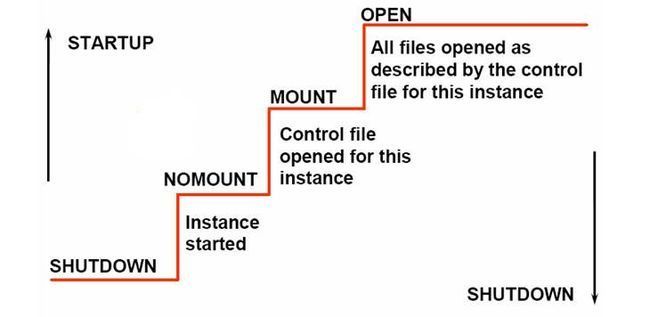Oracle数据库启动过程的几个阶段(SHUTDOWN -> NOMOUNT -> MOUNT -> OPEN)
Oracle数据库启动过程的几个阶段:SHUTDOWN -> NOMOUNT -> MOUNT -> OPEN
1.shutdown immediate
SQL> shutdown immediate Database closed. Database dismounted. ORACLE instance shut down. SQL>
2.nomount
When you issue the startup command, the first thing the database will do is enter the nomount stage. During the nomount stage, Oracle first opens and reads the initialization parameter file (init.ora) to see how the database is configured. For example, the sizes of all of the memory areas in Oracle are defined within the parameter file.
After the parameter file is accessed, the memory areas associated with the database instance are allocated. Also, during the nomount stage, the Oracle background processes are started. Together, we call these processes and the associated allocated memory the Oracle instance. Once the instance has started successfully, the database is considered to be in the nomount stage. If you issue the startup command, then Oracle will automatically move onto the next stage of the startup, the mount stage.
SQL> startup nomount ORACLE instance started. Total System Global Area 171966464 bytes Fixed Size 787988 bytes Variable Size 145488364 bytes Database Buffers 25165824 bytes Redo Buffers 524288 bytes SQL>3.mount
When the startup command enters the mount stage, it opens and reads the control file. The control file is a binary file that tracks important database information, such as the location of the database datafiles.
In the mount stage, Oracle determines the location of the datafiles, but does not yet open them. Once the datafile locations have been identified, the database is ready to be opened.
SQL> startup mountIf you have already started the database instance with the startup nomount command, you might change it from the nomount to mount startup stage using the alter database command:
SQL> alter database mount; Database altered. SQL>4.open
To open the database, you can just use the startup command as seen in this example
SQL> startup
If the database is mounted, you can open it with the alter database open command as seen in this example:
SQL> alter database open; Database altered. SQL>
====================================
start
SQL> startup ORACLE instance started. Total System Global Area 251658240 bytes Fixed Size 788368 bytes Variable Size 145750128 bytes Database Buffers 104857600 bytes Redo Buffers 262144 bytes Database mounted. Database opened.
===EOF===
